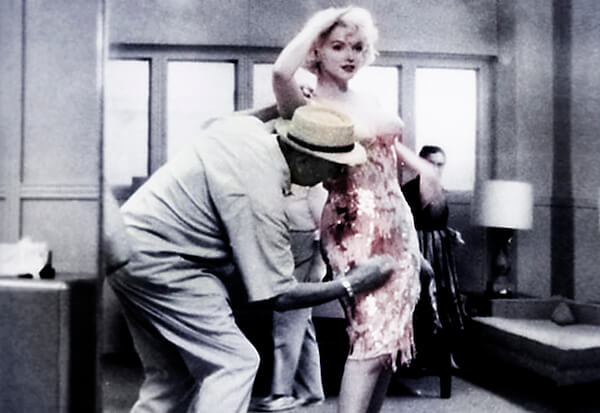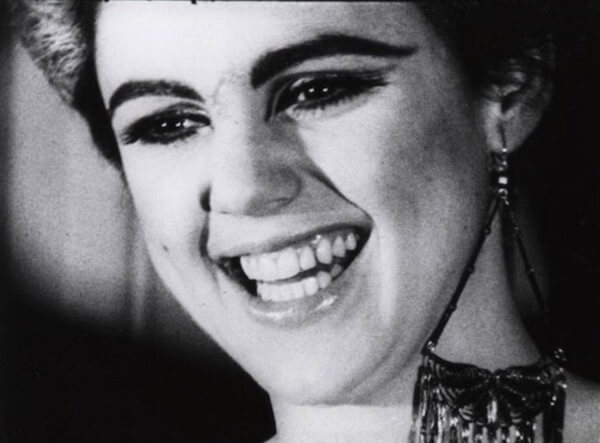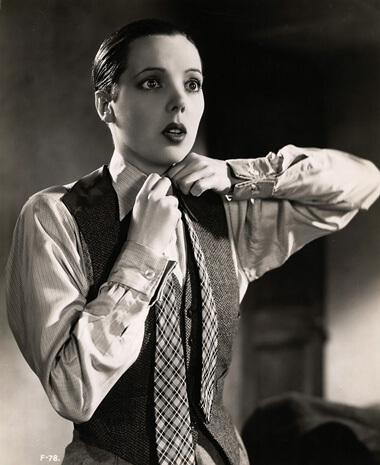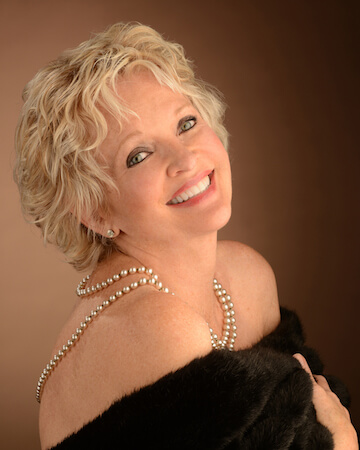Darren Gilshenan as Orry-Kelly in Gillian Armstrong’s “Women He’s Undressed.” | ANNA HOWARD/ WOLFE VIDEO
When asked who was the greatest movie costume designer, some aficionados might pump for the multi-Oscared Edith Head, who used ambition and political maneuvering to drive an astonishingly long career — despite a talent that was mostly just okay.
Or it could be Cecil Beaton who, if he had only done “My Fair Lady,” would be a contender, for both the dreams it fueled everywhere and its inspiration to future designers.
Travis Banton was wholly emblematic of the silvery glory that was Deco Paramount, with his opulently sexy ensembles for the likes of Lombard, Colbert, and his special muse, Marlene Dietrich.
Fifty years after his death, Orry-Kelly’s own story is told in new documentary bio-pic
That unquestioned genius Adrian is naturally in the running, for iconically draping Garbo, Crawford, and Shearer, as well as a little show called “The Wizard of Oz.”
But, for overall versatility and true authenticity — in outfits that served the text of the script, period or modern, rather than showcasing a star — Orry-Kelly may well be the one. Think of Ingrid Bergman in “Casablanca,” cool as a cucumber in Africa, her timeless, simple white ensembles making her the universally desired Woman. Or, on the opposite end of the feminine spectrum, Monroe in “Some Like It Hot,” virtually naked in transparent bespangled soufflé, a Jazz Age — though really 1950s, for who had those tits in the Roaring 20s? — Venus on the half shell.
When it came to exhibitionist high fashion, he was the equal of any with his arresting concoctions for flawless, willowy dark beauties like Kay Francis and Dolores Del Río, as well as the divinely chic Ruth Chatterton, far from willowy, but a superb clotheshorse. And then there was his most famous muse, Bette Davis, for whose career Kelly was a major architect and most constant presence, transforming her into Queen Elizabeth I, Empress Carlotta, an icy Maugham murderess (“The Letter”), a glittery whore disfigured by the Mob (“Marked Woman”), a selfish beauty hanging on to her looks through the decades (“Mr. Skeffington,” a ridiculous film distinguished only by its costumes), and, in their most triumphant collaboration, Charlotte Vale in ”Now Voyager,” a hideous spinster butterflied into beautiful sophistication.
Rosalind Russell, no great beauty herself, knew the importance of a good costumer and remained faithful to Kelly, who’d dressed her magnificently in “No Time for Comedy,” as well as to Banton, even after drink had led to the destruction of their careers. She hired Banton for the stage version of “Auntie Mame,” and Kelly for the film of that and “Gypsy.”
Orry-Kelly is the subject of “Women He’s Undressed,” the first feature length documentary about a movie costume designer, directed by Gillian Armstrong, for whom costumes, starting with her 1979 “My Brilliant Career,” have always been vital. I snatched the opportunity to interview her and she said, “ Orry-Kelly is the man to me. It’s good to talk to aficionados like yourself. It was an amazing career, with such incredible diversity, which you don’t see with many other costume designers.”
The project started “with my producer Damien Parer, whose father, Damien, Sr., had won an Academy Award for ‘The Kokoda Track,’ a World War II documentary. Damien grew up interested in other Aussies who’d won awards. He was researching it and came across Orry, and couldn’t believe that no one in Australia had ever heard of him, someone who won the Oscar three times.”
Surprising, but not shocking, for how many costume designers apart from maybe Edith Head or Bob Mackie can most people name? As important as they are — with costumes being the first thing you see when an actor appears on the screen — designers have traditionally been given short shrift, sometimes without an onscreen credit, as if the actors dressed themselves.
“Damien approached me about doing a documentary about Orry, and here I am in the film business, someone who loves costumes and costume designers, and I had never heard of him! But when I saw the list of his films, I went ‘Ohmigod! He did “Casablanca?” “Irma La Douce?” “Some Like It Hot?”’
“You gotta understand: Kiama, Orry’s home town, is down the south coast, a tiny little town. He came from there in the 1920s and wound up in Hollywood? How did he get there? That’s what I was interested in, and at the same time you have to tell the audience what a costume designer does, so you can understand how great he is.”
Armstrong started with Internet research and discovered much misinformation.
“Then we got going into the archives and found correspondence with Hedda Hopper, Marion Davies, George Cukor. We also heard early on that he had written his memoir, but nobody had been able to find it. Warner Brothers were very helpful, but said they had nothing. At the end, after a year of research, my writer, Katherine Thomson, happened to be in Los Angeles, and she decided to just turn up at the Warner and UCLA archives. Barbara Warner Howard, the daughter of Jack and Ann Warner, came on board and was very enthusiastic because she remembered Orry from when she was a little girl. She rang the Warner archives and said, ‘Please let Katherine in,’ and lo and behold, the day before she turned up they said, ‘We found an unmarked box.’ I think it was like when your best friend clears up your house when you die. The box had personal photos of George Cukor (“Love to Orry”), a picture of Cary Grant, his one-time roommate and rumored lover (‘from your best friend’), drawings from three films.
“All this had been stuffed into an unmarked box which had been completely lost. I think what happened was when Ann Warner’s stuff was all being packed when they were selling the house, someone said, ‘Oh, it’s film stuff that belongs at the Warner archive.’ But it was Orry’s stuff. Our script had been written, and we had talked to [costume designer] Ann Roth and Scotty Bowers [who recently wrote a tell-all about early gay Hollywood], and I happened to be on this local radio station for a short film festival in a country town north of Sydney, going. ‘Please come see the festival, blah blah.’ And the announcer said, ‘What are you working on?’ ‘Oh, working on a doc about a famous Australian, Orry-Kelly.’
“The next day, my agent got an email from this lady who happened to be driving through that area, listening to her radio. She said, ‘If she’s interested, I am a very good friend of his grand niece, who, by the way, has his memoir.’ It was in a particular hall cupboard, where she had hidden it.
“We knew there was a letter to Marion Davies that read, ‘I want you to read what I’ve written about you. Ah, finally finished and looks like we’re going to get a publisher.’ And then he said, ‘Oh, the lawyers read it and I had to change things with him.’ It was stuff about Cary that he was forced to change.”
Armstrong admits that on a personal level the diary isn’t very revealing, “because when you think about it, this is the 1960s. He talks in depth about his friendship with Cary. There’s funny stuff about when they were sharing a speakeasy table and were raided, and when he first got to LA he was broke with Cary. Cary and he had fights and someone would be sleeping on the couch. He told Cary he should go to a speech therapist: ‘You’ll never get anywhere in the movies with that accent,’ and Cary got so angry, he pushed Orry out the door. Really great stuff about their affection and he also talks about how he was later completely cut off by Cary. In his point of view, Cary was always after the main chance for people who were useful to him. He lost all his old friends. The rest of it was all in code, and says things like ‘Be true to yourself.’ He couldn’t talk. The word ‘gay’ hadn’t been developed then, except for ‘a gay old time.’ You can read between the lines.”
Orry-Kelly dressing Marilyn Monroe. | COURTESY: WOLFE VIDEO
There is a certain over-emphasis in the film on this big gay “get” involving a superstar. I would have preferred more focus on the actual work Kelly did with his actors, and Armstrong remarked, “He called his memoir ‘Women I’ve Undressed,’ and recalled all of his leading ladies. He was a huge fan of Bette and said she was one of the smartest actresses he had ever worked with. He said his favorites were the ones who were intelligent. He also talked about working with Marilyn Monroe; they didn’t get along very well. He has this ironic, self-deprecating sense of humor, which we got from his letters and what other people said about him.
“Tony Curtis, in a couple of other documentaries, talked about Orry, who said his bum was smaller than Monroe’s, and she didn’t get his humor. They had a fractious relationship. A lot of the little stories we put in the film, coming from the actor Darren Gilshenan, who plays Orry, are in his own words, setting himself up.”
Random House published the memoirs in Australia and it’s online.
“They’re negotiating for an American release. They did a beautiful job, and used a number of stills and drawings we found during our research. It’s a huge memoir, like a brick. There’s a lot of stuff about his early time in Sydney before he left, and quite a lot about how he was hanging out with this underworld in the criminal scene.”
I was friends with the late Earl Luick, who was Kelly’s predecessor at Warner and told me that producer Jack Warner’s wife Ann was the one who shoved him out when her friend Kelly came along. Armstrong disputed this: “No, no, Orry got his break in 1932, when Jack Warner brought Ruth Chatterton, Kay Francis, and Barbara Stanwyck to the studio. Before that, Warner had been a gritty B-action-picture studio, and now they needed someone for glamour and style. Cary, who was under contract to Paramount, had an agent who recommended Orry to someone at Warner for the job. He took his portfolio to show it to Warner and then he had to present it to Chatterton, whom no one knows anymore, but was the biggest star and the biggest actress of all time then.
“He got to know Ann later, once he started there and they formed a friendship. She did help him a couple of times when he was nearly fired over various issues and had fights with Jack. He volunteered to join the army when World War II broke out, which is interesting because a lot of Hollywood people managed to get out of that. There’s a lot more stuff. He was really burning bridges at both ends and just drank. He didn’t last very long when he came back from the war, and that’s when he was replaced at Warner. And then he got a contract at Fox, and did films with Betty Grable, which was so the opposite of everything he was about, although he had fun with ‘The Dolly Sisters.’”
A highlight of the doc is an interview with Jane Fonda, who worked with Kelly early in her career, very late in his. Recalling the voluptuously overripe Monroe in Kelly’s skintight see-through shift, she waxes so enthusiastically about her breasts that it culminates in her miming being motorboated by them.
“It was hard to arrange an interview with her, she said she couldn’t add much. But then she remembered that Orry’s costume designs always started with the character. She told me she had forgotten going to those George Cukor star-studded parties. George was such a wonderful character and both he and Orry were very kind to her, knowing the pressures she must face as Henry Fonda’s kid.”
WOMEN HE’S UNDRESSED | Directed by Gillian Armstrong | Wolfe Video | $3.99 rental; $14.99 purchase | wolfeondemand.com







































